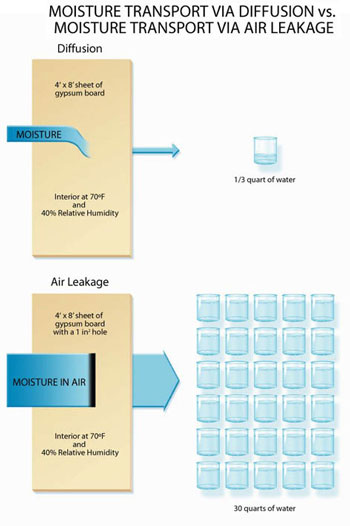Indoor Air Quality (IAQ) and Healthy Homes
Indoor air quality is an important aspect of building science that is often neglected. We breathe about 5,000 gallons of air daily. Indoor air can be more polluted than outdoor air, even in large industrialized cities. Especially at risk are infants and the elderly, who spend almost all of their time indoors.
Heat and Energy Recovery Ventilation
Ventilation can be provided by natural airflow through doors and windows. A heat exchanger (heat or energy recovery ventilation) is an efficient and economical way to have air exchanged and yet reduce heating and cooling costs. Heat exchangers require maintenance to be efficient and effective.
Optimum Relative Humidity
Moisture levels need to be monitored. Too much moisture can cause damage to a home and affect health. Molds and viruses multiply with too much moisture in the home.
At low relative humidity, incidents of respiratory infections and allergic rhinitis increase. Other concerns of low humidity are static electricity, damage to furniture and musical instruments, and dry skin.
Controlling Excess Moisture
 Use exhaust fans when showering
Use exhaust fans when showering
 Repair plumbing leaks
Repair plumbing leaks
 Vent clothes dryer
Vent clothes dryer
 Dry and clean flooded materials
Dry and clean flooded materials
People produce 3 pints of water per day just breathing. Other sources of moisture include cooking, cleaning and taking showers. About one pint of moisture comes from a 10-minute shower. Moisture coming from unsealed crawlspace walls and floors can be up to 100 pints per day with wet soil.
Health Effects of Mold
 Watery or itchy eyes
Watery or itchy eyes
 Sore throat
Sore throat
 Stuffy nose
Stuffy nose
 Coughing
Coughing
 Skin irritations
Skin irritations
 May trigger asthma attacks
May trigger asthma attacks
Molds grow on organic materials, such as wallpaper, carpet, wood, Sheetrock and soap scum. Excessive moisture allows mold to grow rapidly. Mold must be removed since even dead mold can cause problems to our health. Some people are at higher risk for adverse reactions to mold.
Poor Insulation and Air Infiltration
Air leakage accounts for as much as 99 percent of moisture movement in a structure. A seamless insulation and air barrier system is the most effective way at minimizing airflow through the building envelope and protecting against moisture problems to create a healthy, durable, and efficient building system.

Attic Ventilation
Poor or inadequate attic ventilation can lead to problems such as wet insulation, water-damaged ceilings, rotting wood and mold growth. Provide attic ventilation at the eave and the peak or ridge.
Ice Dams
Ice dams occur when escaping heat melts snow on the roof and the water freezes when it reaches the eaves. Reduce the potential for ice dams by providing adequate attic insulation and ventilation, and reducing any air paths from the living space to the attic.
Crawl Space
Crawl spaces and basements can be sources of moisture in a home. Moisture can move through the soil or porous concrete and into the home. Crawl spaces should have a seamless vapor retarder on the soil that is sealed to the foundation. Otherwise, moisture in the crawl space can lead to mold growth, soil odors, and poor indoor air quality inside the home.
Radon
Radon is a colorless, odorless radioactive gas and is the second leading cause of lung cancer in the US. The gas results from the natural decay of uranium and radium in soil and finds its way into homes though cracks and leaks in a building's slab and foundation.
Back to top